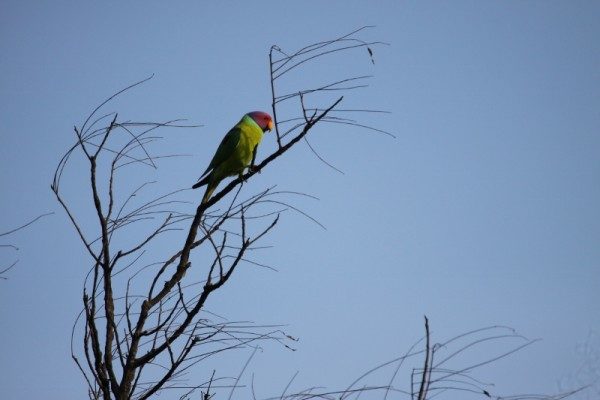Read how one man’s vision and perseverance led to the creation on India’s only man-made sanctuary. It took 15 years of convincing villagers and enlisting their participation, but the beautiful forest is now replete with fauna and flora. Although the man is no longer among us, his legacy still exists for all to see, appreciate and enjoy. Truly, a life well spent!
When a journalist named D. M. Mohite visited the famed Tadoba sanctuary in 1970, he was amazed by the way this forest was being nurtured and protected. And he sadly remembered how an entire forest in his native village of Devrashtra in Sangli was being destroyed by the wanton felling of trees and the insatiable grazing of cattle.
Instantly he saw a vision of the dry mountain slopes in his village being nursed back into the green of health. But it took him 15 tenacious years to convince the villagers and the powers-that-be to actually do it.
This forest is called Sagareshwar Sanctuary, and it’s the only man-made sanctuary in India where all the animals have been re-introduced.
The first thing Mohite did after he came back to his village was to get the villagers to agree to stop the grazing of cattle. Then, with shramadaan (voluntary work through physical effort), he and the villagers planted thousands of indigenous saplings across the length and breadth of this degraded forest. For years, they carried water from the nearby villages and tended to them with love and care. Once these saplings grew up to be young trees, wild animals were brought in with the help of the forest department: sambar deer, spotted deer, blackbuck, fox, wild boar, snakes, mongoose and porcupine. Birds and butterflies though just breezed in!
This forest is also a rare example of continuous upgradation by the forest department over the last three decades. First, it was declared a deer park, then a forest reserve, and then a wildlife sanctuary. It is fenced all around, except for the animal migration corridors. And all this happened when Mohite was still around.
We reached there on a Tuesday, and fortunately the park is closed to casual visitors on all Tuesdays. So we had the entire guest house to ourselves, as also the forest. And it’s truly a great feeling when you have 10 square kms of forest all to yourself.
Though there were over a 100 species of birds there, the national bird was conspicuous by its presence. Their loud calls welcomed us, and as we walked to the first waterhole, we saw them in all moods and poses: some on treetops with their bronze feathers glistening in the morning light; some busy pecking on the morning dew; some perfecting their majestic rain dance; and some gliding down from their perches and leaving behind a streak of ultramarine blue.
But Mohan Karnat, the Chief Conservator of Forests, Kolhapur, shared with us a stunning ecological truth: a spurt in the numbers of peacocks is not a good sign for the habitat! Simply because, being voracious eaters, they polish off copious quantities of newly sprouted grass, thereby destroying the grasslands. In the true wild, this balance is maintained by predators.
Then we saw plum-headed parakeets, green barbets called veda raaghu for their insane flight pattern, hoopoes, crested larks, and a whole colony of baya weaver birds.
A walk in the forest here is enough to convince you that this is an ideal place for eco-tourism. Probably that’s why Mohan Karnat and his dedicated team consisting of S. Zhure and S. Naykal are busy setting up a cluster of beautifully designed cottages, a nature interpretation centre, and an amphitheatre to screen wildlife films so that visitors are sensitized to the forest and all that dwells in it.
Situated at a height of 2700 feet, the scenic Sagareshwar is probably the only wildlife sanctuary that has ‘Points’ like in a hill-station. So you have the Ranshool Point, the Kirloskar Point and the Mahangund Point. As we were trekking up the mountain, I realized the pressures of tourism on this tiny sanctuary.
Inside the forest is the Lingeshwar temple that’s the twin-brother of the Sagareshwar temple outside. So any devotee who visits Sagareshwar feels that he hasn’t collected enough blessings, and makes it a point to visit Lingeshwar to collect some more. Just to give you an idea, the day before we reached here was the last Monday of the month of Shravan, and the sanctuary log showed an entry of, hold your breath, 28,963 visitors! Signs of their devotion were littered all over the place and over 20 people had to work non-stop to tidy up. In fact, our guide Dokle and a young lady forest guard Devki were collecting the trash missed by the earlier team, even as they were spotting birds and bees for us.

In the evening we drove down to Mohityanche Vadgaon, named after the progenitor of this sanctuary, Mohite. The idea was to spot the blackbucks that one fine morning had decided to migrate to this village through the gaps in the fence of the sanctuary. They had moved here a few years ago, and never came back. We did find two groups of blackbucks on the fringes of the farmlands. Maybe they came here looking for their alpha male, Mohite. And are still looking for him.
How to get there: Sagareshwar is around 380 kms from Mumbai. Take the Mumbai-Kolhapur Highway and turn at Karad. The nearest railway station is Sangli.

Where to stay: The Forest Rest House. For bookings, mail at ccfwlkopstr@rediffmail.com or call 02312542766.
All photographs by: Gangadharan Menon
After 28 years in advertising as a writer and creative director, Gangadharan Menon quit the profession to take up his first and second love: teaching and travel. He has over 90 published articles that recount the joy of travelling in this amazing country. A member of Bombay Natural History Society, he is an avid wildlife photographer too. Currently he is working on his first collection of travel writings titled Evergreen Leaves. He can be contacted on wildganges[at]gmail.com






Leave a reply